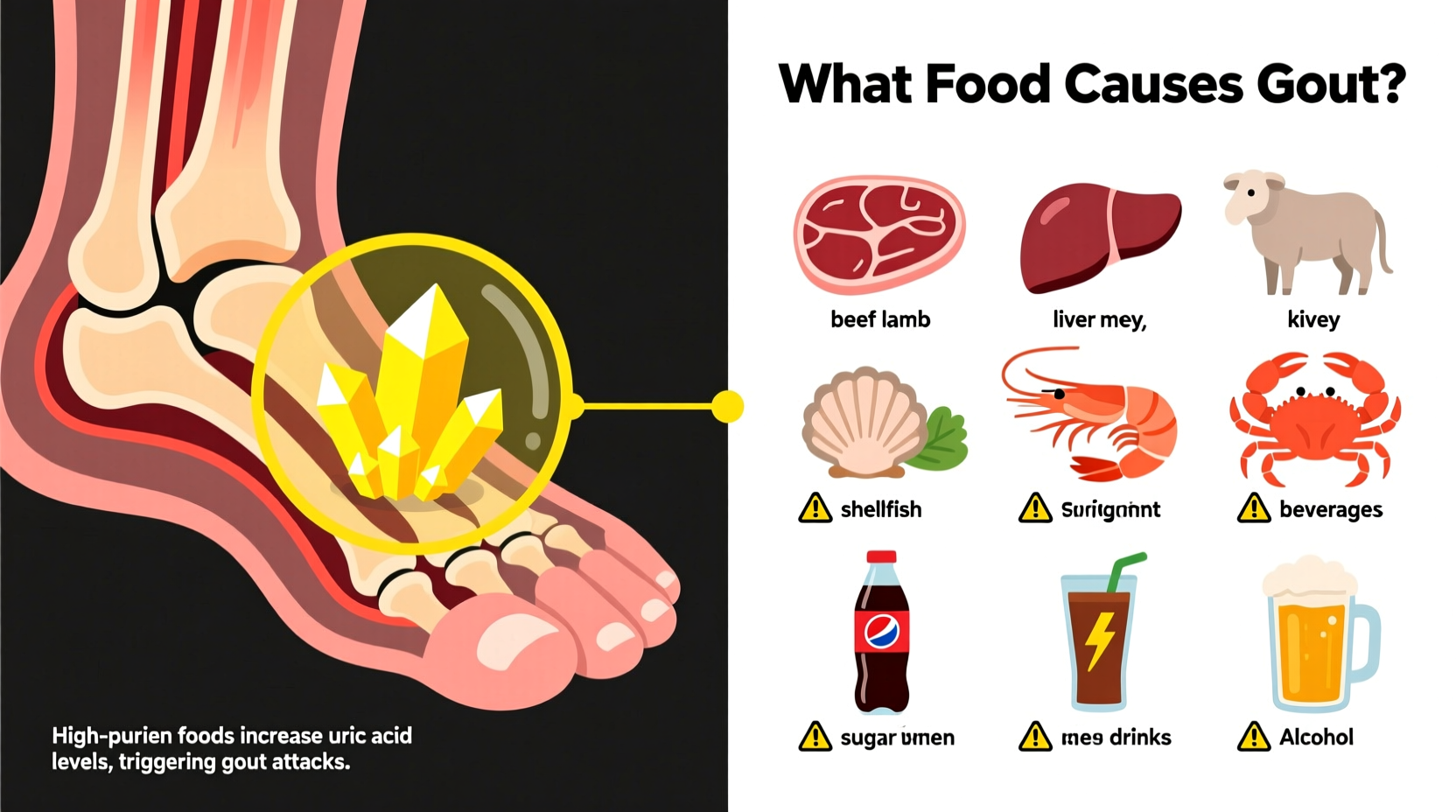Understanding which foods cause gout is critical for managing this painful form of arthritis. When purine-rich foods break down in your body, they form uric acid crystals that trigger sudden, severe joint pain—most commonly in the big toe. The good news: dietary changes can reduce gout flare-ups by 40% according to NIH research.
The Science Behind Food-Induced Gout Attacks
Gout occurs when uric acid crystals accumulate in joints, causing inflammation and intense pain. Purines—natural compounds in certain foods—break down into uric acid during digestion. When your body produces too much uric acid or doesn't eliminate enough, levels rise until crystals form. While genetics play a role, dietary choices significantly impact your risk of painful flare-ups.

Top 5 Dietary Triggers for Gout Flare-Ups
These foods consistently appear in medical studies as major gout triggers due to their high purine content or metabolic effects:
1. Organ Meats: The Highest Risk Category
Liver, kidney, sweetbreads, and other organ meats contain extremely high purine levels. Just 3 ounces of liver delivers over 800mg of purines—more than four times the recommended daily limit for gout sufferers. The American College of Rheumatology specifically advises complete avoidance of organ meats for those with gout history.
2. Certain Seafood Varieties
While fish provides heart-healthy omega-3s, some varieties trigger gout:
| Seafood Type | Purines (mg per 3oz) | Gout Risk Level |
|---|---|---|
| Anchovies, sardines, mussels | 500-1000 | Extremely High |
| Tuna, trout, haddock | 200-400 | Moderate |
| Salmon, catfish | 100-200 | Low |
Research published in Arthritis & Rheumatology found that consuming high-purine seafood increases gout attack risk by 50% within 48 hours compared to low-purine alternatives.
3. Red Meat and Processed Meats
Beef, lamb, and pork contain moderate to high purine levels. Processed meats like bacon and sausages pose double risk—high purines plus inflammatory additives. A CDC analysis showed that reducing red meat consumption by just 2 servings weekly decreased gout flare frequency by 24%.
4. Alcohol, Especially Beer
Alcohol interferes with uric acid elimination, but beer presents triple threat:
- High in purines from yeast
- Alcohol reduces uric acid excretion
- Often consumed with other triggers like salty snacks
The New England Journal of Medicine reports that two beers daily increase gout attack risk fivefold compared to no alcohol. Spirits also elevate risk, while moderate wine consumption shows less consistent association.
5. Sugary Drinks and Fructose
Sweetened beverages containing high-fructose corn syrup significantly increase gout risk. Fructose metabolism directly produces uric acid. Harvard research found that men consuming two or more sugary sodas daily had nearly double the gout risk compared to those drinking less than one monthly.
Context Matters: Individual Variation in Food Triggers
Not everyone reacts identically to these foods. Several factors influence your personal sensitivity:
- Genetic predisposition—some people naturally process purines less efficiently
- Current uric acid levels—those with higher baseline levels react more strongly
- Medication use—certain diuretics increase sensitivity
- Overall dietary pattern—isolated indulgences vs. consistent high-purine diet
The Arthritis Foundation recommends keeping a detailed food diary for 6-8 weeks to identify your personal triggers, as reactions can occur 4-12 hours after consumption.
Gout-Friendly Alternatives to Try
Instead of eliminating entire food groups, focus on strategic substitutions:
- Dairy swap: Choose low-fat dairy products—studies show they may actually lower uric acid
- Fruit focus: Cherries (especially tart varieties) reduce flare frequency by 35% according to Boston University research
- Plant proteins: Tofu and legumes generally pose lower risk than animal proteins despite moderate purine content
- Hydration boost: Drink 8-16 glasses of water daily to help flush uric acid
Creating Your Sustainable Gout Management Plan
Effective gout management combines dietary changes with medical treatment:
- Work with your doctor to establish target uric acid levels (typically below 6.0 mg/dL)
- Implement gradual changes rather than drastic restrictions for better long-term adherence
- Monitor responses using a food-symptom journal for at least two months
- Combine diet with medication—don't replace prescribed treatments with dietary changes alone
- Focus on overall pattern rather than single foods—Mediterranean-style eating shows particular promise
Remember that while diet plays a crucial role, it typically reduces uric acid by only 1-2 mg/dL. For most people with recurrent gout, medication remains essential for reaching target levels, with diet providing valuable complementary benefits.
How quickly can food trigger a gout attack?
Foods high in purines can trigger gout attacks within 4-48 hours. Alcohol and sugary drinks often cause symptoms within 24 hours, while high-purine meals may take up to two days to manifest as joint pain. Individual response times vary based on current uric acid levels and genetic factors.
Are plant-based purines safe for gout sufferers?
Yes, most plant-based purines from legumes, spinach, and mushrooms pose significantly lower risk than animal-based purines. Research shows that vegetable purines don't increase gout risk to the same extent, likely because plant foods contain compounds that counteract uric acid formation. You generally don't need to restrict plant proteins unless specifically advised by your doctor.
Does coffee affect gout?
Moderate coffee consumption (2-3 cups daily) may actually lower gout risk. Multiple studies, including research published in Arthritis & Rheumatism, found that regular coffee drinkers had lower uric acid levels and reduced gout incidence. The mechanism isn't fully understood but may relate to coffee's antioxidant properties. Avoid adding excessive sugar to maintain benefits.
Can I ever eat steak with gout?
You can occasionally enjoy small portions of lean steak (3-4 ounces) as part of a balanced meal, but avoid making it a regular habit. Choose cuts lower in purines like sirloin over ribeye, and pair with gout-friendly foods like vegetables and dairy. Never consume steak alongside other major triggers like alcohol or sugary drinks, which compounds your risk significantly.











 浙公网安备
33010002000092号
浙公网安备
33010002000092号 浙B2-20120091-4
浙B2-20120091-4